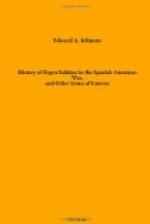The men had the freedom and pass privilege to and from the city.
[Illustration: MAJOR J.B. JOHNSON, OF THE SIXTH VIRGINIA COLORED VOLUNTEERS.]
November 19th the command was ordered to Macon, Ga., arriving at Camp Haskell next day, with 820 men and 27 officers.
Near the camp of the Sixth Virginia was that of the Tenth Immune Regiment, in which were many Virginia boys, some of whom had been members of some of the companies of the Sixth.
Some irresponsible persons cut down a tree upon which several men had been lynched. The blame naturally fell upon the Sixth Virginia. The regiment was placed under arrest and remained so for nineteen days. The first day the Third Engineers guarded the camp, but General Wilson, the Corps commander, removed them and put colored soldiers to guard them. On the night of November 20th, at a late hour, the camp was surrounded by all the troops available while the men were asleep and the regiment was disarmed.
While all this was going on the Thirty-first Michigan Regiment had been deployed into line behind a hill on the north and the Fourth Tennessee had been drawn up in line on the east side of the camp ready to fire should any resistance be offered.
The men quietly submitted to this strange procedure, and did not know that Gatling guns had been conveniently placed at hand to mow them down had they shown any resistance. The Southern papers called them the mutinous Sixth, and said and did every thing to place discredit upon them.
They were reviewed by General Breckinridge, General Alger, Secretary of War, and President McKinley, who applauded them for their fine and soldierly appearance.
COMMENTS ON THE THIRD NORTH CAROLINA REGIMENT.
Of all the volunteer regiments the Third North Carolina seemed to be picked out as the target for attack by the Georgia newspapers. The Atlanta Journal, under large headlines, “A Happy Riddance,” has the following to say when the Third North Carolina left Macon. But the Journal’s article was evidently written in a somewhat of a wish-it-was-so-manner, and while reading this article we ask our readers to withhold judgment until they read Prof. C.F. Meserve on the Third North Carolina, who wrote after investigation.
The Journal made no investigation to see what the facts were, but dwells largely on rumors and imagination. It will be noted that President Meserve took the pains to investigate the subject before writing about it.




